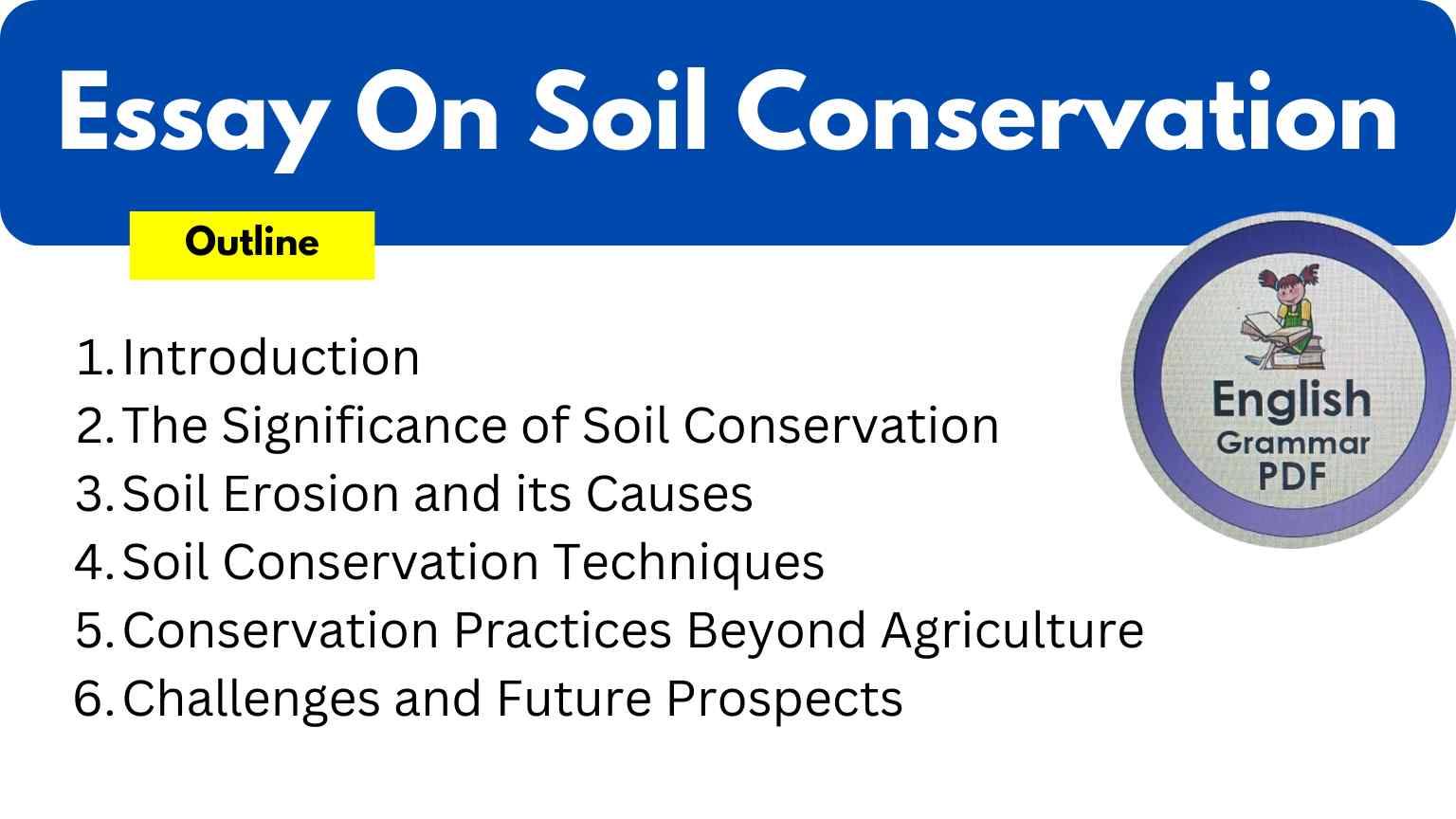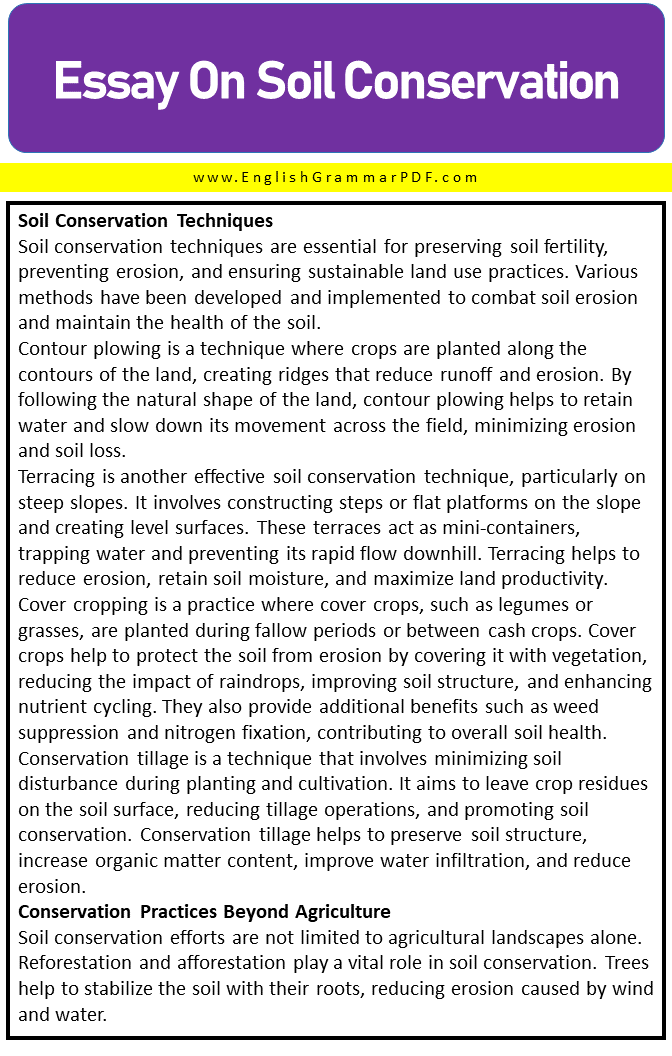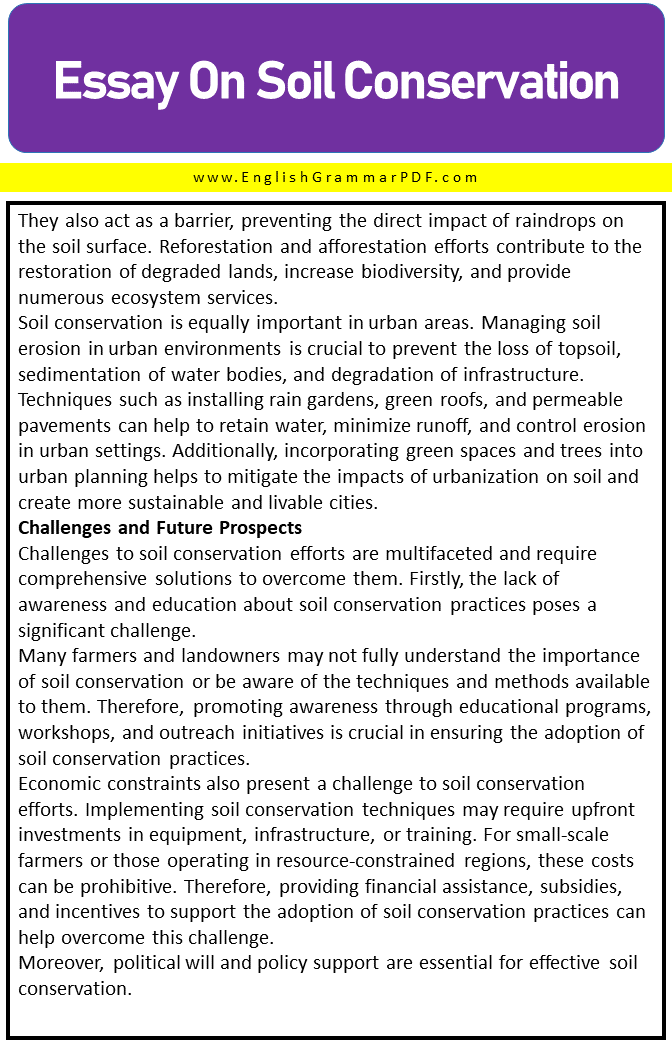Essay On Soil Conservation
Outline of Essay:
- Introduction
- The Significance of Soil Conservation
- Soil Erosion and its Causes
- Soil Conservation Techniques
- Conservation Practices Beyond Agriculture
- Challenges and Future Prospects
Introduction
Soil conservation is the practice of preventing soil erosion and maintaining the health and fertility of the soil. It plays a crucial role in preserving the environment and ensuring sustainable agricultural practices. By implementing effective soil conservation methods, we can protect the earth’s foundation and safeguard the future of our planet. This essay explores the significance of soil conservation, the causes of soil erosion, various soil conservation techniques, conservation practices beyond agriculture, challenges faced, and prospects.
The Significance of Soil Conservation
One of the primary reasons soil conservation is crucial is its role in preserving soil fertility. Soil fertility is essential for agricultural productivity as it provides the necessary nutrients for plant growth. When soil erosion occurs, the top layer of fertile soil is washed or blown away, resulting in a decrease in soil fertility. This, in turn, hampers agricultural productivity and food production. To prevent soil erosion, several methods can be employed, such as contour plowing, terracing, cover cropping, and conservation tillage. These methods help to retain the soil and prevent erosion, thus preserving its fertility and ensuring sustainable agricultural practices.
In addition to preserving soil fertility, soil conservation is essential for the protection of water resources. Soil erosion contributes significantly to water pollution. As soil erodes, sediments and contaminants are carried into rivers, lakes, and other water bodies. This leads to increased turbidity and pollution of the water, affecting aquatic ecosystems. The negative impacts of water pollution include the destruction of habitats, loss of biodiversity, and contamination of drinking water sources. To prevent water pollution caused by soil erosion, soil conservation techniques such as contour plowing, terracing, and cover cropping can be employed. These methods help to control runoff, minimize soil erosion, and preserve water quality.
Soil Erosion and its Causes
Soil erosion is a natural process in which soil particles are detached and transported from one location to another. It occurs as a result of various factors, both natural and human-induced. Understanding the causes of soil erosion is crucial for implementing effective soil conservation measures and mitigating its negative impacts.
Natural causes of soil erosion include wind erosion, water erosion, and glacial erosion. Wind erosion occurs when strong winds blow away loose soil particles from the ground surface. This often happens in arid and semi-arid regions with sparse vegetation cover, where the soil is vulnerable to being picked up and carried away by the wind.
Water erosion occurs when rainfall or runoff moves across the land, washing away the topsoil. This type of erosion is prevalent in areas with steep slopes or compacted soil that cannot absorb water effectively. Glacial erosion occurs when glaciers move over the land, scraping and carrying away soil and rocks.
Human activities also significantly contribute to soil erosion. Deforestation is a major cause as it removes the protective cover of trees that help anchor the soil and absorb rainfall. Without trees, the soil becomes more susceptible to erosion by wind and water.
Unsustainable agricultural practices, such as excessive tilling, monoculture farming, and improper irrigation methods, disrupt the soil structure and increase erosion risk. Urbanization and construction activities also contribute to soil erosion by removing vegetation and altering landscapes, which disrupt the natural processes that stabilize the soil.
Soil Conservation Techniques
Soil conservation techniques are essential for preserving soil fertility, preventing erosion, and ensuring sustainable land use practices. Various methods have been developed and implemented to combat soil erosion and maintain the health of the soil.
Contour plowing is a technique where crops are planted along the contours of the land, creating ridges that reduce runoff and erosion. By following the natural shape of the land, contour plowing helps to retain water and slow down its movement across the field, minimizing erosion and soil loss.
Terracing is another effective soil conservation technique, particularly on steep slopes. It involves constructing steps or flat platforms on the slope and creating level surfaces. These terraces act as mini-containers, trapping water and preventing its rapid flow downhill. Terracing helps to reduce erosion, retain soil moisture, and maximize land productivity.
Cover cropping is a practice where cover crops, such as legumes or grasses, are planted during fallow periods or between cash crops. Cover crops help to protect the soil from erosion by covering it with vegetation, reducing the impact of raindrops, improving soil structure, and enhancing nutrient cycling. They also provide additional benefits such as weed suppression and nitrogen fixation, contributing to overall soil health.
Conservation tillage is a technique that involves minimizing soil disturbance during planting and cultivation. It aims to leave crop residues on the soil surface, reducing tillage operations, and promoting soil conservation. Conservation tillage helps to preserve soil structure, increase organic matter content, improve water infiltration, and reduce erosion.
Conservation Practices Beyond Agriculture
Soil conservation efforts are not limited to agricultural landscapes alone. Reforestation and afforestation play a vital role in soil conservation. Trees help to stabilize the soil with their roots, reducing erosion caused by wind and water. They also act as a barrier, preventing the direct impact of raindrops on the soil surface. Reforestation and afforestation efforts contribute to the restoration of degraded lands, increase biodiversity, and provide numerous ecosystem services.
Soil conservation is equally important in urban areas. Managing soil erosion in urban environments is crucial to prevent the loss of topsoil, sedimentation of water bodies, and degradation of infrastructure. Techniques such as installing rain gardens, green roofs, and permeable pavements can help to retain water, minimize runoff, and control erosion in urban settings. Additionally, incorporating green spaces and trees into urban planning helps to mitigate the impacts of urbanization on soil and create more sustainable and livable cities.
Challenges and Future Prospects
Challenges to soil conservation efforts are multifaceted and require comprehensive solutions to overcome them. Firstly, the lack of awareness and education about soil conservation practices poses a significant challenge.
Many farmers and landowners may not fully understand the importance of soil conservation or be aware of the techniques and methods available to them. Therefore, promoting awareness through educational programs, workshops, and outreach initiatives is crucial in ensuring the adoption of soil conservation practices.
Economic constraints also present a challenge to soil conservation efforts. Implementing soil conservation techniques may require upfront investments in equipment, infrastructure, or training. For small-scale farmers or those operating in resource-constrained regions, these costs can be prohibitive. Therefore, providing financial assistance, subsidies, and incentives to support the adoption of soil conservation practices can help overcome this challenge.
Moreover, political will and policy support are essential for effective soil conservation. Governments need to recognize the importance of soil conservation and enact policies that incentivize sustainable land management practices. This includes developing regulations, providing funding and resources, and integrating soil conservation into broader environmental and agricultural policies.
Despite these challenges, there are promising innovations and prospects for soil conservation. Technological advancements have led to the development of tools and techniques that aid in soil conservation efforts. For example, precision agriculture technologies enable farmers to apply fertilizers and irrigation more accurately, minimizing the risk of soil erosion and nutrient runoff. Remote sensing and geospatial data can also help identify areas prone to erosion and guide targeted conservation interventions.
Furthermore, sustainable agriculture practices that prioritize soil health and conservation are gaining momentum. Agroecological approaches such as organic farming, agroforestry, and crop rotation not only enhance soil fertility but also promote biodiversity, reduce chemical inputs, and mitigate erosion risks. These practices prioritize long-term soil health and contribute to sustainable food production systems.
FAQ’s
How can we save our soil?
By implementing soil conservation practices such as contour plowing, terracing, cover cropping, and conservation tillage, we can prevent soil erosion, enhance soil fertility, and promote sustainable land management.
Why is soil important?
Soil is essential for sustaining life on Earth. It provides nutrients for plant growth, filters, and stores water, supports biodiversity, and plays a crucial role in carbon sequestration and climate regulation.
Download the PDF of the Essay:
Explore More Essays:
Essay On Joan Didion On Going Home








